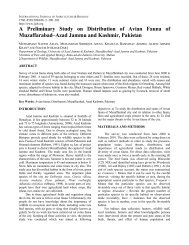Notes on Typhlops diardi - the Wildlife of Pakistan Website
Notes on Typhlops diardi - the Wildlife of Pakistan Website
Notes on Typhlops diardi - the Wildlife of Pakistan Website
Create successful ePaper yourself
Turn your PDF publications into a flip-book with our unique Google optimized e-Paper software.
2<br />
insects and <strong>the</strong>ir larvae, are mostly oviparous, some<br />
are partially viviparous and even par<strong>the</strong>nogenetic<br />
(Smith, 1943; Dowling and Duellman, 1978; FitzSim<strong>on</strong>s,<br />
1962; Fitch, 1970; Deuve, 1970; McDowell, 1974). Blind<br />
snakes are most widely distributed due to <strong>the</strong>ir small<br />
size and easy transport by <strong>the</strong> human agency (McDowell,<br />
1974; Nussbaum, 1980; Hahn, 1980; Shine and Webb, 1990;<br />
Ota, et al., 1991).<br />
Their small simple uniform morphology, leaves<br />
little for tax<strong>on</strong>omists to find important enough<br />
morphological variati<strong>on</strong>s to base new taxa. Mainly due to<br />
<strong>the</strong>se difficulties blind snakes have attracted little<br />
attenti<strong>on</strong> as compared to relatively larger species.<br />
Perhaps it is why <strong>on</strong>ly two species <strong>of</strong> typhlopids<br />
<strong>Typhlops</strong> porrectus and Ramphotyphlops braminus have so<br />
far been recorded from <strong>Pakistan</strong> and <strong>the</strong> adjoining Azad<br />
Kashmir (Smith, 1941; Mint<strong>on</strong>, 1966; Mertens, 1969;<br />
Khan, 1982; Q. Khan, 1996; Q. Khan and Khan, 1996).<br />
During past several years, present author has<br />
received several collecti<strong>on</strong>s <strong>of</strong> snakes from Goi Madan,<br />
Kotli, Azad Kashmir, through <strong>the</strong> curtsy <strong>of</strong> an old<br />
student Master Muhammad Sadiq. The snakes c<strong>on</strong>tain six<br />
specimens <strong>of</strong> stout typhlopids, which are identified as<br />
<strong>Typhlops</strong> <strong>diardi</strong> a new record for <strong>Pakistan</strong> and Azad<br />
Kashmir (Q. Khan and Khan, 1996).<br />
<strong>Typhlops</strong> <strong>diardi</strong> is well known Indian, Indo-Chinese<br />
and Malayan species, extending between l<strong>on</strong>gitude 85 to<br />
135 o E, Latitude 10 to 25 o N. Its discovery from Kotli<br />
Azad Kashmir drags its range far east-northwards to 33 o<br />
30' N and 74 o 00'E (Khan and Tasnim, 1990). Smith (1943)<br />
distinguished two subspecies <strong>of</strong> <strong>Typhlops</strong> <strong>diardi</strong> <strong>on</strong> <strong>the</strong><br />
basis <strong>of</strong> scale rows at midbody and geographical<br />
distributi<strong>on</strong>: <strong>Typhlops</strong> <strong>diardi</strong> <strong>diardi</strong> with 24-26, rarely<br />
28 midbody scales, no str<strong>on</strong>g c<strong>on</strong>trast between brownblack<br />
dorsum and paler ventrum, ranges from north <strong>of</strong><br />
lat. 16 o ,Bengal, Assam, Myanmar and French Indo-China.<br />
<strong>Typhlops</strong> <strong>diardi</strong> mülleri with 24-26, rarely 22 scales<br />
round <strong>the</strong> midbody, with clear demarcati<strong>on</strong> between black<br />
olive-brown dorsum and yellowish ventrum. Ranges south<br />
<strong>of</strong> lat. 14 o , Myanmar, Siam and French Indo-China, <strong>the</strong><br />
Malay Peninsula and Archipelago.<br />
Recently O'Shea has collected several specimens <strong>of</strong><br />
<strong>Typhlops</strong> d. <strong>diardi</strong> from tarai z<strong>on</strong>e <strong>of</strong> Nepal, extending<br />
its range 700 km westward (O'Shea, in press). Present<br />
records are 900 km west <strong>of</strong> <strong>the</strong> Nepalese locality,<br />
dragging overall range to 1600 km west <strong>of</strong> its l<strong>on</strong>g known<br />
range in Bengal. Morphological comparis<strong>on</strong> <strong>of</strong> present<br />
2




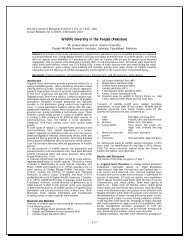
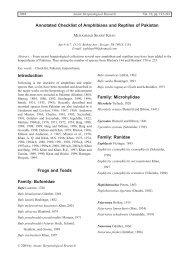



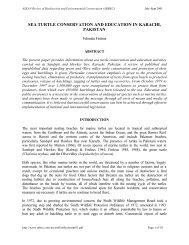
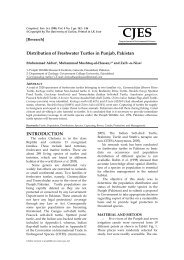
![Dureji (Ovis orientalis [vignei] blanfordi) - Wildlife of Pakistan](https://img.yumpu.com/11814520/1/190x245/dureji-ovis-orientalis-vignei-blanfordi-wildlife-of-pakistan.jpg?quality=85)
